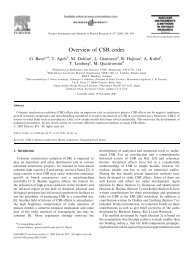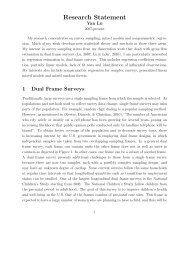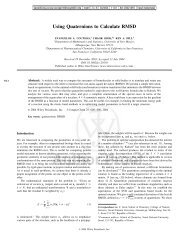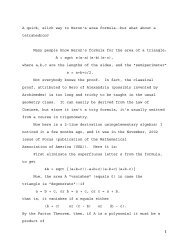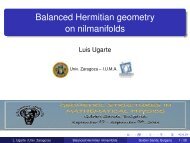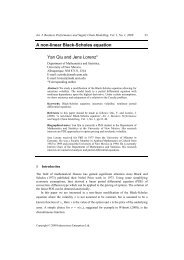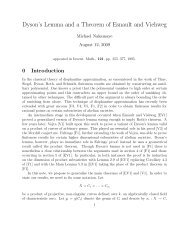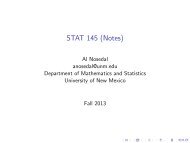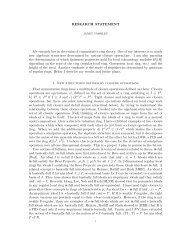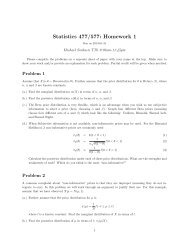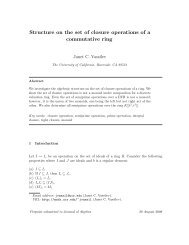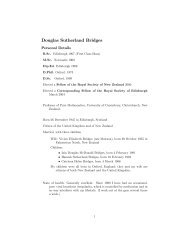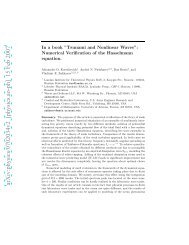OEO Office of Equal Opportunity - Department of Mathematics and ...
OEO Office of Equal Opportunity - Department of Mathematics and ...
OEO Office of Equal Opportunity - Department of Mathematics and ...
You also want an ePaper? Increase the reach of your titles
YUMPU automatically turns print PDFs into web optimized ePapers that Google loves.
190 ARTS AND SCIENCES<br />
353. Later Shakespeare. (3)<br />
Survey <strong>of</strong> Shakespeare’s Jacobean-era drama <strong>and</strong> poetry,<br />
including such works as Measure for Measure, Macbeth,<br />
The Tempest <strong>and</strong> the sonnets. Examines dramatic structure,<br />
characterization, poetics <strong>and</strong> a variety <strong>of</strong> themes in their<br />
historical context.<br />
354. Milton. (3)<br />
Comprehensive study <strong>of</strong> Milton’s poetry <strong>and</strong> prose with<br />
the context <strong>of</strong> 17th-century history <strong>and</strong> <strong>of</strong> Milton criticism.<br />
Alternates between focus upon Paradise Lost <strong>and</strong> shorter<br />
poems, <strong>and</strong> upon Paradise Regained, Samson Agonistes<br />
<strong>and</strong> prose.<br />
355. Enlightenment Survey. (3)<br />
Literature <strong>and</strong> culture <strong>of</strong> the English Enlightenment (1650-<br />
1800), the construction <strong>of</strong> the modern world: the new science,<br />
exploration, empire. Experiments in theatre, satire, fiction:<br />
Dryden, Behn, Pope, Defoe, Swift, Fielding, Lennox, Austen.<br />
356. The Nineteenth Century. (3)<br />
A survey <strong>of</strong> 19th Century literature <strong>and</strong> culture, primarily<br />
focused on British <strong>and</strong> Irish literature, covering a wide range<br />
<strong>of</strong> authors <strong>and</strong> a variety <strong>of</strong> genres from the Romantic through<br />
the Victorian periods.<br />
360. Individual Authors. (3 to a maximum <strong>of</strong> 6) ∆<br />
Study <strong>of</strong> one or more authors. Titles <strong>of</strong> individual sections<br />
vary as content varies.<br />
364. Native Literatures <strong>and</strong> Rhetorics. (3 to a maximum<br />
<strong>of</strong> 6) ∆<br />
A focused examination <strong>of</strong> the oral traditions, literatures, rhetorics,<br />
criticism, film, art, drama, <strong>and</strong> ceremonies specific to<br />
individual American Indian <strong>and</strong> indigenous nations, periods,<br />
genders, classes <strong>and</strong>/or regions.<br />
365. Chicana/o Cultural Studies. (3 to a maximum <strong>of</strong> 6)<br />
∆<br />
An examination <strong>of</strong> contemporary Chicano/a literature, criticism,<br />
murals, film, <strong>and</strong> other forms <strong>of</strong> popular culture, with an<br />
emphasis on the construction <strong>and</strong> representation <strong>of</strong> Chicano/<br />
a cultural identity.<br />
381. Black Books II. (3)<br />
(Also <strong>of</strong>fered as AFAM 381.) This is the second phase <strong>of</strong> a<br />
three part journey through the Black experience in search <strong>of</strong><br />
humanity <strong>and</strong> peace. The vehicle is post-slavery books written<br />
by <strong>and</strong> about books written by <strong>and</strong> about Black people.<br />
Issues raised <strong>and</strong> the characters in the books provide the<br />
occasion for in-depth discussion <strong>of</strong> inhumanity, protests, self<br />
definition, race relationships, liberalism, etc.<br />
397. Regional Literature. (3)<br />
The study <strong>of</strong> a limited body <strong>of</strong> writers whose work is identified<br />
with a particular geographical region. Authors covered will<br />
differ but representative examples are Frank Waters, Willa<br />
Cather, Rudolfo Anaya <strong>and</strong> Walter Van Tilburg Clark.<br />
406. The Folktale in English. (3)<br />
Tradition <strong>of</strong> folk motifs <strong>and</strong> themes in development <strong>of</strong> the tale<br />
as a form <strong>of</strong> storytelling in English <strong>and</strong> American literature.<br />
410./510. Criticism <strong>and</strong> Theory. (3 to a maximum <strong>of</strong> 6) ∆<br />
A historical survey <strong>of</strong> literary criticism <strong>and</strong> theory; alternates<br />
between criticism from the classical period through the early<br />
19th century, <strong>and</strong> criticism <strong>and</strong> theory from the late 19th century<br />
through the present.<br />
411./511. Special Topics: Criticism <strong>and</strong> Theory, Literary<br />
<strong>and</strong> Cultural Movements. (3 to a maximum <strong>of</strong> 12) ∆<br />
Advanced study <strong>of</strong> various topics in literary <strong>and</strong> cultural studies,<br />
literary criticism <strong>and</strong> theory. Recent topics have included<br />
Linguistics <strong>and</strong> Literary Criticism, Cultural Theory, Literature<br />
<strong>and</strong> National Identity.<br />
412. Capstone <strong>and</strong> Honors Seminar. (3)<br />
Seminar bringing together literary, rhetorical, <strong>and</strong>/or theoretical<br />
works from different times or cultural moments. Students<br />
do in-depth research with a clear theoretical base <strong>and</strong> give<br />
oral presentations <strong>of</strong> their work.<br />
432. Topics in Literature <strong>and</strong> Culture. (3 to a maximum<br />
<strong>of</strong> 6) ∆<br />
(Also <strong>of</strong>fered as COMP <strong>and</strong> FREN 432.) Varying topics in the<br />
practice <strong>and</strong> theory <strong>of</strong> literatures <strong>and</strong> cultures.<br />
440./540. Topics in Language or Rhetoric. (3 to a maximum<br />
<strong>of</strong> 12) ∆<br />
An overview <strong>of</strong> a defined theme or issue in language or<br />
rhetorical theory. Recent topics have included Discourse<br />
Analysis/Text Linguistics, Survey <strong>of</strong> American English,<br />
Narrative Theory <strong>and</strong> Literature, Epistemic Rhetoric <strong>and</strong><br />
Language Studies, such as Old Norse. Repeatable to a<br />
maximum <strong>of</strong> 12 credit hours.<br />
441./541. English Grammars. (3)<br />
(Also <strong>of</strong>fered as LING 441.) A survey <strong>of</strong> various grammar<br />
models <strong>and</strong> their applications to analysis <strong>of</strong> the English<br />
language.<br />
Prerequisite: 240 or LING 101 or LING 292.<br />
442./542. Major Texts in Rhetoric. (3)<br />
A survey <strong>of</strong> rhetorical <strong>and</strong> language theories from the classical<br />
period through the 18th century.<br />
443./543. Contemporary Texts in Rhetoric. (3)<br />
A survey <strong>of</strong> rhetorical <strong>and</strong> language theories from the 19th<br />
<strong>and</strong> 20th centuries that shape contemporary approaches to<br />
discourse, text <strong>and</strong> persuasion.<br />
445./545. History <strong>of</strong> the English Language. (3)<br />
A historical survey <strong>of</strong> the etymology, morphology, phonetics<br />
<strong>and</strong> semantics <strong>of</strong> English, as well as the relation between the<br />
English language <strong>and</strong> cultural change.<br />
447./547. Old English. (3 to a maximum <strong>of</strong> 6) ∆<br />
(Also <strong>of</strong>fered as LING 447./547.) An introduction to the<br />
grammar, syntax, <strong>and</strong> phonology <strong>of</strong> Old English. Prepares<br />
students for more advanced studies in this <strong>and</strong> later periods.<br />
448./548. Topics in Medieval Studies. (3 to a maximum<br />
<strong>of</strong> 6) ∆<br />
Advanced study <strong>of</strong> specialized aspects in medieval studies,<br />
such as manuscripts; paleography; literary <strong>and</strong> historical bibliographic<br />
methods; medieval Latin sources; cultural, feminist,<br />
<strong>and</strong> historical theoretical approaches to literature; medievalism<br />
in Britain <strong>and</strong> America; history <strong>of</strong> scholarship.<br />
449./549. Middle English Language. (3)<br />
(Also <strong>of</strong>fered as LING 449./549.) Comprehensive study<br />
<strong>of</strong> Middle English dialects <strong>and</strong> the development <strong>of</strong> Middle<br />
English from Old English. Prepares students for Middle<br />
English literature.<br />
450./550. Beowulf <strong>and</strong> Other Topics. (3 to a maximum<br />
<strong>of</strong> 6) ∆<br />
Alternates between Beowulf <strong>and</strong> Advanced Old English,<br />
Anglo-Saxon Prose <strong>and</strong> special topics in Old English.<br />
Prerequisite: 449.<br />
451./551. Topics in Medieval Studies. (3 to a maximum<br />
<strong>of</strong> 6) [3 to a maximum <strong>of</strong> 9] ∆<br />
Advanced study <strong>of</strong> specialized aspects in medieval studies,<br />
such as manuscripts; paleography; literary <strong>and</strong> historical bibliographic<br />
methods; medieval Latin sources; cultural, feminist,<br />
<strong>and</strong> historical theoretical approaches to literature; medievalism<br />
in Britain <strong>and</strong> America; history <strong>of</strong> scholarship.<br />
452./552. The Renaissance. (3 to a maximum <strong>of</strong> 6) ∆<br />
Survey <strong>of</strong> prose, poetry <strong>and</strong>/or drama <strong>of</strong> the 16th century.<br />
Emphasis varies.<br />
453./553. The Seventeenth Century. (3 to a maximum<br />
<strong>of</strong> 6) ∆<br />
Survey <strong>of</strong> prose, poetry <strong>and</strong>/or drama <strong>of</strong> the 17th century.<br />
Emphasis varies.<br />
UNM CATALOG 2006–2007 Symbols, page 611.



